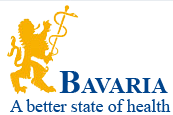ULTRASONOGRAPHY
Screening and duplex ultrasonography
If you want to learn more about check-ups, click on one of the topics below.
1st screening: 9th-12th week of pregnancy (integrity of pregnancy, single / multiple pregnancy, anomalies)
Nuchal scan
Nuchal translucency measurement is carried out by an ultrasonic scan of the fluid behind the neck of the foetus known as the nuchal fold. The scan is carried out between the 11th and 14th week of pregnancy. Foetuses with trisomy 21 (Down syndrome) tend to have a larger nuchal fold. A normal nuchal fold does, however, not prove that there is definitely no Down syndrome!
Measuring the nuchal translucency can detect whether or not your child is likely to suffer from a genetic disease such as trisomy 21 or trisomy 18. The scan can only estimate the risk for trisomy 21.
This measurement is combined with blood sampling (PAPP-A and ß-HCG). This increases accuracy up to 94%.
An accurate statement on trisomy 21 can only be given by e.g. chorionic villus sampling (CVS) or an examination of amniotic fluid (amniocentesis). This means that even after the nuchal scan it is not 100% clear whether or not your baby suffers from trisomy 21. However, this scan can help you to decide whether you want to have another diagnostic test later, e.g.an examination of the amniotic fluid.
After the 14th week of pregnancy, the lymphatic fluid is reduced in all babies. This examination will not carry any increased risk to you or your child.
2nd screening: 19th-22nd week of pregnancy (exclusion of foetal malformation / foetal organ screening)
Malformation screening
Ultrasonic examinations between the 19th and 22nd week of pregnancy can detect many developmental disorders, among them a number of foetal malformations and diseases. The criteria of the assessment are, for example, the face, head, spine, abdominal wall, extremities and individual foetal organs. An ultrasonic examination with normal results confirms with high probability a normal development of the foetal organ; however, it can never exclude disorders in the foetal development with certainty.
Even when the examination is carried out with high-quality devices and utmost care by an experienced doctor, it cannot be expected that all malformations and modifications can be detected at any time during pregnancy because some anomalies only develop during the course of pregnancy. The assessment of the unborn child may be difficult due to unfavourable examination conditions, e.g. low level of amniotic fluid, unfavourable position of the child, too early or too late in pregnancy, strong maternal abdominal wall, scars. Thus, a residual risk at a percent level for developmental disorders still remains.
If a malformation is diagnosed, we can offer you cooperation with experts in the respective field (e.g. paediatricians, paediatric cardiologists, human geneticists, psychologists).

fig.: normal four-chamber view of the foetal heart in the 20th week of pregnancy
3rd screening: 29th-32nd week of pregnancy (growth, position, estimation of foetal weight, evaluation of foetal heart)
3rd screening: 29th-32nd week of pregnancy (growth, position, estimation of foetal weight, evaluation of foetal heart)
Doppler ultrasonography examination of maternal / foetal vessels depending on indication
Doppler sonography
Doppler sonography measures the blood flow velocity within the maternal and foetal vessels. The blood flows in different foetal vessels (umbilical cord, cerebral arteries), in the uterine arteries or in the foetal heart are displayed in different colours and measured in flow curves. This helps to detect anomalies in the foetus’s circulation. Indirect hints are given as to whether the child is provided with sufficient nutrients and oxygen. Assessing the blood flow pattern in the uterine arteries can help to detect and monitor an increased risk of insufficient supply of nutrients to the foetus (placental insufficiency) or pre-eclampsia (pregnancy-induced hypertension with proteinuria) between the 20th and 24th week of pregnancy already.
The most common reasons for using Doppler sonography are the following:
-
within focussed ultrasound scans in case of suspected foetal malformations, developmental and chromosomal disorders
-
blood flow diagnostics in case the baby is too small in view of the gestational age
-
hypertensive diseases during pregnancy, other maternal diseases
foetal echocardiography (ultrasonography of the foetal heart) to exclude cardiac defects
Foetal echocardiography
In Germany, about 6000 children with heart defects are born each year. One in 100 newborns suffers from a type of heart anomaly, which is one of the most common malformations.
The aim of foetal echocardiography is to detect heart defects or cardiac arrhythmia in foetuses.
This examination is recommended in case of the following risk factors:
-
familial predisposition on the part of the mother or children already born with a congenital heart defect
-
previous maternal diseases, such as diabetes mellitus, lupus erythematosus, epilepsy, etc.
-
infections during pregnancy, such as cytomegalovirus or coxsackievirus infections
-
existing other anomaly of the unborn child which has already been detected e.g. by means of amniocentesis orultrasound malformation screening
-
special substances which have been consumed during pregnancy, e.g. anti-epileptic drugs, lithium, alcohol or vitamin A
-
high doses of ionising radiation
During foetal echocardiography, the ventricles, atria, cardiac septum and all afferent and efferent vessels are examined. The ideal point in time for such examination is between the 20th and 26th week of pregnancy. In case of existing risk factors, it can already be performed in the 13th week of pregnancy.

fig.: normal four-chamber view of the foetal heart in the 20th week of pregnancy




























